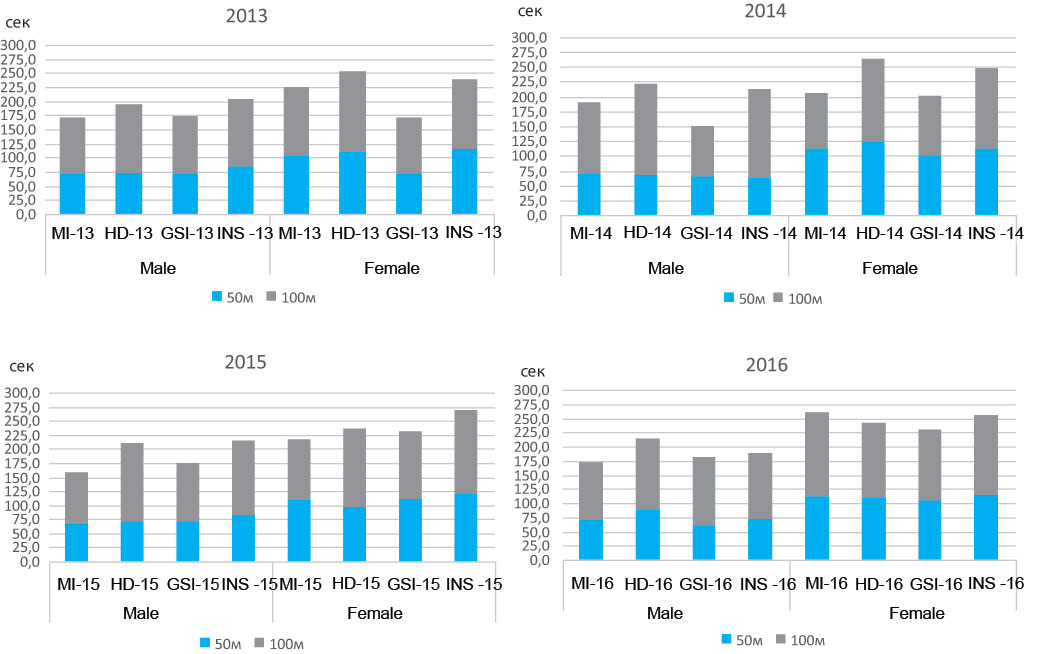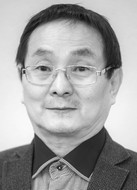First-year students’ swimming tests with comparative analysis prior to practical training
Фотографии:
ˑ:
PhD, Associate Professor N.N. Kladkin1
M.N. Protodyakonova1
PhD, Associate Professor M.I. Sentizova1
L.L. Platonova1
1Institute of Physical Culture and Sport of Ammosov North-Eastern Federal University, Yakutsk
Keywords: comparative analysis, swimming course, first-year student, qualification for practical training, test rate.
Background. Swimming course as a part of the academic physical education and sport curriculum is ranked among the most important physical education and sport methods by the northern educational system for many reasons including the life safety considerations – as the swimming skills may be critical both in the off-class time and during academic practical training in the summer season [4, 5].
Long-term first-year students’ swimming test data, however, show their swimming test indices varying in a wide range from year to year – for the reason that a varying part of the first-year students comes each year from the far north and arctic Yakut communities where swimming basics may not be learnt even in summer time. This northern/ arctic part of the first-year student population has always faced problems in the attempts to cope with the swimming tests. Despite the fact that most of them are more or less capable to keep up in shallow water they still have a fear to swim in the deep part of the swimming pool as this fear is rather traditional and typical for their communities [1-3].
Objective of the study was to make a comparative analysis of the first-year students’ swimming test indices used to qualify them for the academic summer practical training.
Methods and structure of the study. The study was performed at North-Eastern Federal University in 2013 through 2016, with the students sampled in the following University units: Mining Institute (MI), Geological Survey Department (GSD), Institute of Natural Sciences (INS), and History Department (HD). The 17-20 year-old (n=1783, including 630 females and 1153 males) first-year students, were sampled for the study. The sample was split up into four gender groups composed of 10-12 female and 15-17 male students each.
The 50m/ 100m swimming (optional style) tests were used to qualify the students for the summer academic practical training, with the tests having been run from February to early June for four years prior to the practical training.
Study findings and discussion. 1377 students including 470 females and 907 males, successfully passed the tests. For the male groups, the average department-specific 50m test indices (for the 4-year test period) equaled 66.4s for GSD; 68.9s for MI; 75.2s for HD; and 76.0s for INS. The 100m test rate (for the 4-year test period) averaged 173.0s for GSD; 173.3s for MI; 184.8s for HD and 190.1s for INS: see Figure 1 hereunder.

Figure 1. Department- and gender-group specific swimming test rates for 4 years
For the female groups, the average department-specific 50m test index (for the 4-year test period) made up 96.5s for GSD; 108.5s for MI; 109.7s for HD; and 115.4s for INS. The 100m test rate averaged 223.2s for GSD; 248.8s for MI; 250.0s for HD and 253.5s for INS.
The test data for the 4 year period showed the Geological Survey Department’s leadership in the swimming tests followed by the Mining Institute and History Department. The students of the Institute of Natural Sciences were rated the lowest in the swimming tests.
Conclusion. The study data and analyses showed that the limited time from February to May is too short for the progress in the swimming course. We believe that the whole student population should be subject to the swimming practices since the first semester. It was found that the swimming abilities of the first-year students directly depend on how systemic their swimming practices are.
References
- Zhizhin V.I., Nikitin V.M., Oksman V.S. et al. Geologo-sjemochnaya praktika. Ucheb. posobie [Geological surveying practice. Study guide]. Yakutsk: YSU publ., 2005, 113 p.
- Kladkin N.N. Zachet po plavaniyu dlya studentov-geologov kak dopusk k letney uchebno-polevoy praktike (na primere Severo-Vostochnogo federalnogo universiteta) [Swimming test for geological students to be admitted to summer practical training (case study of North-Eastern Federal University)]. Teoriya i praktika fiz. kultury, 2012, no. 10, pp. 44-47.
- Kladkin N.N. Obuchenie plavaniyu studentov pered vyezdom na letnyuyu uchebno-polevuyu praktiku (na primere gorno-geologicheskikh spetsialnostey YaGU). Ucheb. posobie [Swimming trainings for students before summer practical training (case study of mining and geological specialties of YSU) Study guide]. Yakutsk: YSU publ, 2008, 86 p.
- Bulgakova N.Zh., Morozov S.N., Popov O.I. Plavanie. Uchebnik [Swimming. Textbook]. Moscow: INFRA-M publ., 2017, 290 p.
- Chertov N.V. Teoriya i metodika plavaniya. Uchebnik [Swimming theory and methods. Textbook]. Rostov-on-Don: SFU publ., 2011, 452 p.
Corresponding author: 706037@mail.ru
Abstract
The study analyses the North-Eastern Federal University first-year students’ (four groups) swimming test data, with the 50m/ 100m swimming (optional style) tests used to qualify the students for the summer academic practical training. The study has been performed at North-Eastern Federal University in 2013 through 2016, with the students sampled in the following University units: Mining Institute (MI), Geological Survey Department (GSD), Institute of Natural Sciences (INS), and History Department (HD). The 17-20 year-old (n=1783, including 630 female and 1153 male) first-year students were sampled for the study. The sample was split up into four gender groups of 10-12 female and 15-17 male students each.
The study data and analyses showed that the limited time from February to May is too short for the progress in the swimming course. We believe that the whole student population should be subject to the swimming practices from the first semester. It was found that the swimming progress of the first-year students directly depends on how systemic their swimming practices are.



